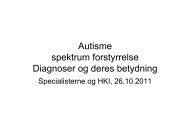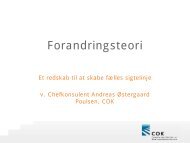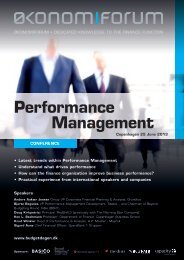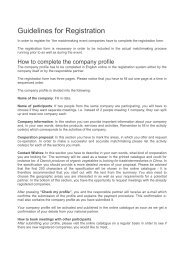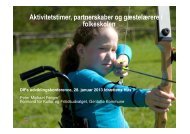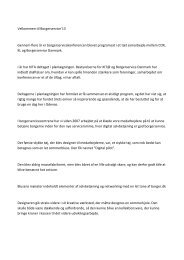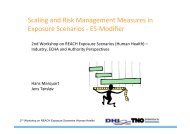Innovation Network Denmark Performance Accounts 2011
Innovation Network Denmark Performance Accounts 2011
Innovation Network Denmark Performance Accounts 2011
Create successful ePaper yourself
Turn your PDF publications into a flip-book with our unique Google optimized e-Paper software.
<strong>Innovation</strong> <strong>Network</strong> <strong>Denmark</strong><br />
<strong>Performance</strong> <strong>Accounts</strong> <strong>2011</strong><br />
<strong>Innovation</strong>: Analyse og evaluering 08/<strong>2011</strong>
<strong>Innovation</strong> <strong>Network</strong> <strong>Denmark</strong><br />
<strong>Performance</strong> <strong>Accounts</strong> <strong>2011</strong><br />
Published by:<br />
This publication can also be downloaded from www.fi.dk<br />
The Danish Agency for Science,<br />
Technology and <strong>Innovation</strong><br />
Bredgade 40<br />
Internet ISSN: 1902-889X<br />
ISSN: 1902-8555<br />
DK-1260 Copenhagen K<br />
Tel: +45 35446200<br />
Fax: +45 35446201<br />
Print: CS Grafisk A/S<br />
Design: Formidabel Aps<br />
E-mail: fi@fi.dk<br />
Circulation:1000<br />
These performance accounts have been prepared<br />
by Iris Group for The Danish Agency for Science,<br />
Technology and <strong>Innovation</strong><br />
This publication is supplied free of charge while stocks last.<br />
Please apply to:<br />
Rosendahls - Schultz Grafisk<br />
Herstedvang 10<br />
2620 Albertslund<br />
distribution@rosendahls-schultzgrafisk.dk
<strong>Innovation</strong> <strong>Network</strong> <strong>Denmark</strong><br />
<strong>Performance</strong> <strong>Accounts</strong> <strong>2011</strong><br />
The Danish Agency for Science, Technology and <strong>Innovation</strong><br />
May <strong>2011</strong><br />
<strong>Performance</strong> <strong>Accounts</strong> <strong>2011</strong> 3
TABLE OF CONTENTS<br />
><br />
1. INTRODUCTION 6<br />
2. THE INNOVATION NETWORKS AND THE MEASUREMENT SYSTEM 8<br />
3. THE INNOVATION NETWORKS’ RESULTS AND RESOURCES 12<br />
4. THE INNOVATION NETWORKS’ ACTIVITIES 17<br />
APPENDIX 1 PERFORMANCE ACCOUNTS <strong>2011</strong> IN NUMBERS 25<br />
APPENDIX 2 BRIEF PRESENTATION OF ALL INNOVATION NETWORKS 29<br />
LIST OF PUBLICATIONS 2009-<strong>2011</strong> 33<br />
<strong>Performance</strong> <strong>Accounts</strong> <strong>2011</strong> 5
1. INTRODUCTION<br />
><br />
The main purpose of the <strong>Performance</strong> <strong>Accounts</strong> is to present the activities of the<br />
innovation networks, as well as the effects of these activities. In brief: how much<br />
collaboration and innovation has resulted from the support given by the State (and<br />
others) to the innovation networks?<br />
The innovation networks are national clusters within various technologies and<br />
disciplines. The innovation networks are one of the key Danish initiatives to boost<br />
innovation in Danish business and industry. The innovation networks can achieve<br />
this by building bridges between Danish business and industry and the substantial<br />
knowledge production at universities, other research and education institutions,<br />
and technological service institutes. The innovation networks play a particularly<br />
important role in helping small and medium-sized enterprises to get started on<br />
using the knowledge available from knowledge institutions. Via outreach initiatives,<br />
information activities, conferences, matchmaking offers, innovation projects, etc.<br />
the networks function as the gateway to the knowledge institutions, and the right<br />
researchers and trainers.<br />
The innovation networks’ performance in terms of results and activities is measured<br />
on an annual basis. These <strong>Performance</strong> <strong>Accounts</strong> are the fifth in the series and<br />
present the results of the innovation networks in 2010, and their development from<br />
2006 to 2010. The <strong>Performance</strong> <strong>Accounts</strong> for the year focus on the figures, and<br />
in contrast to previous years the <strong>Accounts</strong> do not include special analyses or case<br />
studies.<br />
The <strong>Performance</strong> <strong>Accounts</strong> include the following sections:<br />
Section 2 provides an overview of the existing networks, and the measurement<br />
system for the <strong>Performance</strong> <strong>Accounts</strong> is introduced.<br />
Section 3 presents the networks’ results in the form of knowledge building and dissemination<br />
and greater innovation in companies.<br />
Section 4 lists a series of figures for the networks’ activity level measured by three<br />
core activities: 1) bridge building and meeting places; 2) partnership projects; and 3)<br />
dissemination of knowledge.<br />
Appendix 1 presents an overview of the <strong>Performance</strong> Account numbers. This consists<br />
of the 15 analysed networks’ total results, activities and resources in 2010, and<br />
the development from 2007 to 2010.<br />
Appendix 2 provides a brief description of each of the 22 networks in existence as<br />
of 1 May <strong>2011</strong>.<br />
<strong>Performance</strong> <strong>Accounts</strong> <strong>2011</strong> 6
2. OVERVIEW OF THE INNOVATION NETWORKS AND THE<br />
MEASUREMENT SYSTEM<br />
><br />
2.1. THE 22 INNOVATION NETWORKS<br />
In 2010 there were a total of 22 networks. Seven of these networks commenced<br />
their activities at the end of 2010, and these seven are therefore not included in<br />
these <strong>Performance</strong> <strong>Accounts</strong>.<br />
Table 2.1. lists the innovation networks as of 1 May <strong>2011</strong>, while Appendix 2 presents<br />
the activities of the individual networks. The seven newly-started networks<br />
that are not included in this year’s <strong>Performance</strong> <strong>Accounts</strong> are marked in italic.<br />
Table 2.1. The 22 innovation networks as of 1 May <strong>2011</strong><br />
Area<br />
Energy<br />
Name and year of establishment<br />
Offshore Center Danmark (2003)<br />
<strong>Innovation</strong>snetværket VE-Net / Renewable Energy <strong>Network</strong> (2006)<br />
<strong>Innovation</strong>snetværket for biomasse / <strong>Innovation</strong> network for biomass (2010)<br />
Environment<br />
<strong>Innovation</strong>snetværket for miljøteknologi / The <strong>Innovation</strong> network for Environmental Technology<br />
(2010)<br />
Partnerskabet Vand i byer / Partnership for Water in urban areas (2010)*<br />
ICT<br />
InfinIT – <strong>Innovation</strong>snetværk for IT / The Danish ICT <strong>Innovation</strong> network (2009)<br />
<strong>Innovation</strong>snetværket Animation Hub / The Animation Hub (2009)<br />
Experience economy and turism<br />
Production, new materials<br />
<strong>Innovation</strong>snetværk for videnbaseret oplevelsesøkonomi – InVIO / <strong>Innovation</strong> network for knowledge<br />
based experience economy (2010)<br />
<strong>Innovation</strong>snetværket AluCluster / Knowledge and technology centre for aluminium (1999)<br />
<strong>Innovation</strong>snetværket Livsstil - Bolig & Beklædning / Innonet Lifestyle – Interior & Clothing (2001)<br />
<strong>Innovation</strong>snetværket RoboCluster / <strong>Innovation</strong> <strong>Network</strong> Robocluster (2003)<br />
<strong>Innovation</strong>snetværket Dansk Lydteknologi / The Danish Sound Technology <strong>Network</strong> (2009)<br />
<strong>Innovation</strong>snetværket Dansk Lys / Danish Lighting <strong>Innovation</strong> <strong>Network</strong> (2010)<br />
<strong>Innovation</strong>snetværket PlastNet / Plastic and Polymer <strong>Network</strong> (2009)<br />
Food stuff<br />
Food <strong>Network</strong> - Fødevaresektorens <strong>Innovation</strong>snetværk / Food <strong>Network</strong> (2009)<br />
<strong>Performance</strong> <strong>Accounts</strong> <strong>2011</strong> 8
Health/medico<br />
Biopeople – <strong>Innovation</strong>snetværk for biosundhed / Biopeople – <strong>Innovation</strong> <strong>Network</strong> for Biotech (2009)<br />
Partnerskabet Lev Vel, innovation til ældre / No Age - innovative solutions for elderly people (2010)*<br />
Partnerskabet UNIK, innovative løsninger til kronisk syge / UNIC - Use of New technologies in<br />
Innovative solutions for Chronic patients (2010)*<br />
Construction<br />
Transport<br />
Service<br />
InnoBYG – <strong>Innovation</strong>snetværket for energieffektivt og bæredygtigt byggeri / InnoBYG - <strong>Innovation</strong><br />
network for energy efficient and sustainable construction (2010)<br />
Transportens <strong>Innovation</strong>snetværk / The Transport <strong>Innovation</strong> <strong>Network</strong> (2009)<br />
<strong>Innovation</strong>snetværket Service Platform / Service Cluster <strong>Denmark</strong> (2010)<br />
<strong>Innovation</strong>snetværket for Marked, Kommunikation og Forbrug – <strong>Innovation</strong> network for Market,<br />
Communication and consumption (2010)<br />
Chart 2.1. Development in the number of innovation networks in 2006-2010.<br />
40<br />
35<br />
30<br />
25<br />
20<br />
15<br />
10<br />
5<br />
0<br />
2006 2007 2008 2009 2010<br />
2.2. HOW THE RESULTS AND RESOURCES ARE MEASURED<br />
Together with the Danish Agency for Science, Technology and <strong>Innovation</strong>, the IRIS<br />
Group has developed a measurement system with a series of interrelated indicators<br />
that can present a view of the innovation networks’ effects. The basic elements of<br />
the measurement system are presented in chart 2.2 below.<br />
Chart 2.2 System for measurement of the networks’ results<br />
Resources<br />
Activities in the<br />
networks<br />
Knowledge building<br />
and dissemination<br />
<strong>Innovation</strong><br />
Economic<br />
effects<br />
• 76,2 mio. kr. i<br />
statslige<br />
investeringer<br />
• 3.659 aktive<br />
virksomheder<br />
(uddybes i afsnit4)<br />
• 822 virksomheder<br />
i projekter<br />
• 14 videninstitutioner<br />
• 300 virksomheder<br />
udvikler nye<br />
produkter/ydelser<br />
• 1,1 mia. kr. i øget<br />
omsætning (skøn)<br />
<strong>Performance</strong> • 4,8 Medarbejdere <strong>Accounts</strong> <strong>2011</strong><br />
pr. netværk<br />
pr. netværk • 750 udvikler nye<br />
kompetencer<br />
• 550 får tilført nye<br />
9
The Chart should be read from the left. First, the <strong>Performance</strong> <strong>Accounts</strong> measure<br />
the input of resources to the networks. Measurement is by considering the amounts<br />
invested by the State and others in the networks in 2010, and the number of employees<br />
in the networks (arrow 1). The input of resources is described in section 3.<br />
Arrow 2 shows the activities in the networks. The activities are measured via a<br />
large number of indicators – there are a total of nine core activities in the networks.<br />
On the result side, the <strong>Performance</strong> <strong>Accounts</strong> first consider a statement of the<br />
networks’ knowledge building and knowledge dissemination (arrow 3). The number<br />
of companies that in 2010 – as a direct consequence of participation in a network –<br />
entered into partnership projects with knowledge institutions is measured, as well<br />
as the number of knowledge institutions involved in the networks.<br />
On the result side, it is also measured how far the transfer of knowledge led to innovation<br />
in the companies (arrow 4). This is shown in the <strong>Performance</strong> <strong>Accounts</strong> by<br />
the number of companies that developed new products or services as a consequence<br />
of participation in a network, and by the number of companies that in 2010 gained<br />
new competences or ideas due to participation in a network.<br />
As an introduction to the presentation of the results it must be emphasised that it is<br />
naturally not an easy task to compile the effect of the innovation networks. Some<br />
effects will not be apparent until after five to ten years. Other effects are indirect<br />
and relate to the benefits of a change of “mindset” in both companies and knowledge<br />
institutions with regard to the opportunities presented by knowledge networks.<br />
Nonetheless, the measurement system is a contribution to taking stock of these<br />
benefits.<br />
The information has been gathered via a comprehensive questionnaire survey of all<br />
network contacts in April <strong>2011</strong>. All the fifteen relevant networks responded to the<br />
survey.<br />
<strong>Performance</strong> <strong>Accounts</strong> <strong>2011</strong> 10
3. THE INNOVATION NETWORKS’ RESULTS AND RESOURCES<br />
><br />
3.1. RESULTS<br />
INNOVATION AND COMPETENCE FOR INNOVATION IN COMPANIES<br />
The purpose of drawing more, and new, companies into partnership projects with<br />
many different knowledge institutions is to create more innovation. Chart 3.1. presents<br />
the number of companies that have achieved new competences, new ideas or<br />
new products, services and concepts as a consequence of participating in networks<br />
in 2007-2010.<br />
Chart 3.1. The companies’ results of network participation 2007-2010<br />
1000<br />
900<br />
800<br />
700<br />
600<br />
500<br />
400<br />
300<br />
2007<br />
2008<br />
2009<br />
2010<br />
200<br />
100<br />
0<br />
New competences<br />
that significantly<br />
increase<br />
innovation ability<br />
New ideas that<br />
can later lead to<br />
innovation<br />
New products,<br />
services or processes<br />
Chart 3.2. presents the innovative results measured by network. More than 20<br />
companies per network innovated new products, services or concepts in 2010, and<br />
almost 60 companies per network gained new competences that can be used in<br />
relation to innovation.<br />
<strong>Performance</strong> <strong>Accounts</strong> <strong>2011</strong> 12
Chart 3.2. The companies’ innovation per network, 2007-2010<br />
2007<br />
New products, services<br />
or processes<br />
2008<br />
2009<br />
2010<br />
New ideas that<br />
can later lead to<br />
innovation<br />
New competences that<br />
significantly increase<br />
innovation ability<br />
0<br />
10<br />
20<br />
30<br />
40<br />
50<br />
60<br />
70<br />
Number of companies per network<br />
NUMBER OF COMPANIES IN PARTNERSHIP PROJECTS<br />
The networks bring companies and knowledge institutions together via a number<br />
of activities that include individual matchmaking for companies and researchers, as<br />
well as idea generation in order to design concrete partnership projects. These are<br />
activities aimed at concrete partnership projects that can help researchers try out<br />
new knowledge in practice, and also meet smaller companies’ need for rapid and<br />
visible results.<br />
Chart 3.3. shows the number of companies that in 2006-2010 cooperated with the<br />
knowledge institutions as a consequence of being “brought together” in the network.<br />
Chart 3.3. Number of companies engaged in projects with knowledge institutions<br />
as a consequence of their participation in an innovation network, 2006-2010<br />
1200<br />
1000<br />
Companies that participated<br />
in collaborative projects<br />
800<br />
600<br />
400<br />
200<br />
0<br />
2006 2007 2008 2009 2010<br />
Of which companies with<br />
fewer than 50 employees<br />
Companies that participated<br />
in collaborative projects for<br />
the first time<br />
Of which companies with<br />
fewer than 50 employees<br />
<strong>Performance</strong> <strong>Accounts</strong> <strong>2011</strong> 13
DIFFERENT TYPES OF KNOWLEDGE INSTITUTIONS ARE INVOLVED<br />
IN NETWORKS<br />
It is vital that many knowledge institutions are active in the networks if the<br />
networks are to promote innovation in the companies. This augments the body<br />
of knowledge that is available to the companies. In addition, the participation of<br />
a wide selection of knowledge institutions contributes to laying the foundations<br />
for the sharing and dissemination of knowledge among various research areas<br />
and disciplines – which ultimately benefits the companies’ innovation.<br />
For 2006-2010, Table 3.1. presents the number of knowledge institutions that annually<br />
attended the networks’ activities (measured by the average participation<br />
per network). The Table also presents the development in the total number of<br />
entities from knowledge institutions - for example a university department - that<br />
participated in innovation projects under the networks’ auspices.<br />
Table 3.1. Participation in innovation networks by knowledge institutions<br />
2006 2007 2008 2009 2010<br />
Number of knowledge institutions<br />
participating in the networks’ overall<br />
activities – average per network<br />
7 13 11 14 16<br />
Total number of entities from<br />
knowledge institutions participating<br />
in innovation projects under the<br />
119 105 139 109 132<br />
networks<br />
*from 2010 the foreign universities are also included in this figure<br />
Chart 3.4. shows the percentage of innovation networks that involve the various<br />
types of knowledge institution in their work.<br />
Chart 3.4. Percentage of networks that involve various types of knowledge<br />
institution, 2008-2010<br />
Business schools and<br />
business academies<br />
Knowledge institutions abroad<br />
University colleges and<br />
vocational colleges<br />
GTS (Certified Advanced Technology<br />
Group Institutes)<br />
2008<br />
2009<br />
2010<br />
Danish universities<br />
0<br />
10<br />
20<br />
30<br />
40<br />
50<br />
60<br />
70 80 90 100<br />
Percentage of the networks<br />
<strong>Performance</strong> <strong>Accounts</strong> <strong>2011</strong> 14
Chart 3.5. shows that most networks to a high degree perceive themselves as business<br />
and industry’s gateway to knowledge institutions all over the country.<br />
Chart 3.5. The networks’ response to the question “Should the network function as<br />
business and industry’s gateway to knowledge institutions all over the country?”<br />
Percent of network<br />
90<br />
80<br />
70<br />
60<br />
50<br />
40<br />
30<br />
20<br />
10<br />
0<br />
2008<br />
2009<br />
2010<br />
To a high degree To some degree To a small<br />
degree<br />
Not at all<br />
3.2. RESOURCES: HOW ARE THE NETWORKS FINANCED?<br />
The overall results and activities in the networks should be viewed in the light of the<br />
resources available to the networks. The networks’ turnover totalled DKK 152 million<br />
(~ 20 million euro) in 2010, which corresponds to turnover of just over DKK 10 million<br />
(~ 1.3 million euro) per network. Chart 3.6. shows how these funds were provided.<br />
Chart 3.6. Financing of the networks, 2008-2010<br />
90.000.000<br />
80.000.000<br />
70.000.000<br />
60.000.000<br />
2008<br />
2009<br />
2010<br />
50.000.000<br />
40.000.000<br />
30.000.000<br />
20.000.000<br />
Danish<br />
kroner<br />
0<br />
Central government<br />
Companies<br />
Other<br />
Knowledge institutions<br />
EU<br />
Regions and municipalities<br />
10.000.000<br />
<strong>Performance</strong> <strong>Accounts</strong> <strong>2011</strong> 15
<strong>Performance</strong> <strong>Accounts</strong> <strong>2011</strong> 16<br />
>
4. THE INNOVATION NETWORKS’ NINE CORE ACTIVITIES<br />
><br />
4.1. AREAS OF ACTIVITY<br />
The networks’ results are achieved from the many different opportunities they offer<br />
to companies and knowledge institutions. There are fundamentally three main categories<br />
of activities in the networks: 1) bridge building and establishment of meeting<br />
places; 2) partnership projects; and 3) dissemination of knowledge. Within these<br />
three categories there are a total of nine different core activities undertaken by the<br />
networks, cf. Chart 4.1.<br />
The circles in Chart 4.1. overlap to illustrate the strong mutual dynamic between the<br />
activities. For example, consulting and sparring can lead a company to participate<br />
in a thematic network – and on this basis later to conduct a pre-project.<br />
Chart 4.1. The networks offer nine core activities – within three main categories<br />
2.<br />
Partnership projects<br />
Pre-projects<br />
<strong>Innovation</strong> projects<br />
Company partnerships<br />
1.<br />
Bridge building<br />
and establishment<br />
of meeting places<br />
Conferences, seminars, etc.<br />
Thematic networks<br />
Matchmaking Idea<br />
generation<br />
3.<br />
Knowledge<br />
dissemination<br />
Consulting and sparring<br />
Competence development<br />
4.2. THE DEVELOPMENT IN THE NETWORKS’ OVERALL LEVEL OF<br />
ACTIVITY<br />
Chart 4.2. below shows that a total of 3,155 different companies participated in the<br />
networks’ activities in 2010.<br />
An average of 210 companies participated in each network’s activities. There is<br />
considerable variation, however, in how many companies the individual networks<br />
involve in their activities.<br />
<strong>Performance</strong> <strong>Accounts</strong> <strong>2011</strong> 17
Chart 4.2. Total number of participants in the network’s activities, 2006-2010<br />
4.500<br />
4.000<br />
3.500<br />
3.000<br />
2.500<br />
2.000<br />
1.500<br />
1.000<br />
500<br />
0<br />
2006 2007 2008 2009 2010<br />
Number of active companies<br />
Of which with fewer than 50 employees<br />
Chart 4.3. Number of companies participating in the networks’ activities that did<br />
not come from the network’s own region 2008-2010<br />
60<br />
54%<br />
56%<br />
50<br />
45%<br />
40<br />
30<br />
20<br />
10<br />
0<br />
2008 2009 2010<br />
Table 4.1. presents the four types of core activity offered by the innovation networks<br />
in terms of bridge building and establishment of meeting places. The Table lists the<br />
number of networks that offered each activity, and the number of companies that<br />
participated in the activity in 2010.<br />
<strong>Performance</strong> <strong>Accounts</strong> <strong>2011</strong> 18
Table 4.1. Activities with focus on bridge building and establishment of meeting<br />
places<br />
Activity Description Number out of the<br />
15 networks that<br />
offered the activity<br />
Number of<br />
companies<br />
participating in 2010<br />
Conferences,<br />
seminars, etc.<br />
Comprises everything from workshops to thematic<br />
seminars to conferences. Gives insights on new<br />
knowledge and used as networking fora.<br />
15 2.276<br />
Thematic<br />
networks<br />
Matchmaking<br />
Idea generation<br />
A fixed group of researchers and companies that meet<br />
regularly in order to share knowledge within a current<br />
field and create the basis for shared project activities –<br />
for example innovation projects.<br />
Assistance to individual companies and researchers<br />
in finding suitable partners for a concrete project, or to<br />
solve a concrete problem.<br />
The purpose of the processes is to lead to new<br />
partnership projects on the basis of a concrete idea or a<br />
new research result<br />
9 495<br />
12 829<br />
10 732<br />
Chart 4.4. Number of companies participating in four different types of bridgebuilding<br />
activities in the networks, 2006-2010<br />
3500<br />
2006<br />
3000<br />
2007<br />
2500<br />
2008<br />
2000<br />
2009<br />
Number of companies<br />
1500<br />
1000<br />
500<br />
0<br />
Conferences,<br />
seminars, etc<br />
Thematic<br />
networks<br />
Matchmaking<br />
2010<br />
Idea generation<br />
<strong>Performance</strong> <strong>Accounts</strong> <strong>2011</strong> 19
Chart 4.5. Percentage of the networks offering various types of services on<br />
matching companies and researchers, 2008-2010<br />
Esablishment of<br />
special databases<br />
Help to write grant<br />
applications<br />
2008<br />
2009<br />
2010<br />
Outreach work<br />
among comanies<br />
Idea development -<br />
concretisation of idea<br />
Information on<br />
financing<br />
Facilitation of meetings<br />
between companies and<br />
knowledge institutions<br />
0<br />
10<br />
20<br />
30 40 50 60 70 80 90<br />
Percentage of networks<br />
4.4. PARTNERSHIP PROJECTS<br />
The innovation networks may initiate and co-finance partnership projects in which<br />
knowledge institutions and companies jointly develop new knowledge and create<br />
innovation. For the companies, the purpose is to develop a new technology, a new<br />
product or a new service, or other development of its business activities. For the<br />
knowledge institutions, the aim is typically to test new knowledge in practice, and<br />
thereby achieve new insights that can be applied to research or used in teaching.<br />
Table 4.2. presents three types of partnership project; the number of networks that<br />
offered each activity; and how many companies participated in 2010.<br />
Table 4.2. Different types of partnership project<br />
Activity Description Number out of the<br />
15 networks that<br />
offered the activity<br />
Number of<br />
companies<br />
participating in 2010<br />
<strong>Innovation</strong><br />
projects<br />
Partnership projects between companies and<br />
knowledge institutions for the purpose of developing a<br />
new technology, a new product, a new service, etc.<br />
13 587<br />
Pre-projects<br />
Projects to clarify the basis for an actual innovation<br />
project, such as the investigation of a new idea, smallscale<br />
trials, the sustainability of the team, etc.<br />
6 226<br />
Company<br />
INNOVATION PROJECTS<br />
partnerships<br />
Activities that bring companies together to tackle concrete<br />
challenges or business opportunities. Knowledge<br />
(b2b)<br />
institutions do not participate in these partnerships.<br />
8 443<br />
<strong>Performance</strong> <strong>Accounts</strong> <strong>2011</strong> 20
INNOVATION PROJECTS<br />
Chart 4.6. Total number of companies in innovation projects under the networks’<br />
auspices, 2006-2010<br />
700<br />
600<br />
500<br />
400<br />
300<br />
200<br />
100<br />
0<br />
2006<br />
2007 2008 2009 2010<br />
Total number<br />
of companies<br />
Of which companies with<br />
fewer than 50 employees<br />
Chart 4.7 Number of knowledge institutions participating in innovation projects,<br />
2008-2010<br />
Other<br />
Approved Technological<br />
Service Institutes<br />
2008<br />
2009<br />
2010<br />
Business schools and<br />
business academies<br />
University colleges<br />
and vocational colleges<br />
Danish universities<br />
*Foreign universities<br />
0<br />
10<br />
20<br />
30<br />
40<br />
50<br />
60<br />
*Participation by foreign universities is included as from 2010<br />
<strong>Performance</strong> <strong>Accounts</strong> <strong>2011</strong> 21
PRE-PROJECTS<br />
Chart 4.8. Number of companies participating in pre-projects in the innovation<br />
networks, 2007-2010<br />
450<br />
400<br />
350<br />
300<br />
250<br />
2007<br />
2008<br />
2009<br />
2010<br />
200<br />
150<br />
100<br />
50<br />
0<br />
Number of companies participating<br />
in pre-projects<br />
Number of entities from<br />
knowledge institutions<br />
COMPANY PARTNERSHIPS<br />
Chart 4.9. Number of companies participating in company partnerships (b2b<br />
projects with no participation by knowledge institutions) in the innovation<br />
networks, 2008-2010<br />
Other type<br />
of cooperation<br />
Partnership on<br />
production-related<br />
challenges<br />
2008<br />
2009<br />
2010<br />
Partnership on innovation<br />
and business development<br />
Pre-competitive<br />
technology partnership<br />
Development<br />
of supplier partnership<br />
0<br />
50<br />
100<br />
150 200 250 300<br />
<strong>Performance</strong> <strong>Accounts</strong> <strong>2011</strong> 22
4.5. KNOWLEDGE DISSEMINATION<br />
The third overall category of activities in the innovation networks is “knowledge<br />
dissemination”. The networks have strong insights on the ground-breaking knowledge<br />
that is continuously being developed at the knowledge institutions. They are<br />
in regular contact with researchers, attend national and international conferences,<br />
and are updated on the latest technology developments or the newest methods.<br />
They are also familiar with the challenges that companies face, and have a good<br />
understanding of how the new knowledge might benefit specific companies. The<br />
networks therefore play a key role in constantly deploying their insights on the two<br />
worlds to ensure that the right knowledge is put to use by the right users.<br />
Table 4.3. presents the nature of the two types of knowledge dissemination - consulting<br />
and sparring, and competence development – and the number of networks with<br />
that type of activity, as well as the number of companies that participated in knowledge<br />
dissemination of the type in question.<br />
Table 4.3. Different types of knowledge dissemination<br />
Activity Description Number out of<br />
the 15 networks<br />
that offered the<br />
activity<br />
Number of<br />
companies<br />
participating<br />
in 2010<br />
Consulting and sparring<br />
Offer of consulting or individual<br />
sparring – based on new<br />
knowledge and research from<br />
the universities and consulting<br />
on project financing and<br />
assistance with the preparation<br />
of applications<br />
12 596<br />
Competence<br />
development<br />
In partnership with universities<br />
and other educational<br />
institutions the networks can<br />
contribute to developing new,<br />
company-oriented education<br />
programmes within the<br />
networks' disciplines.<br />
6 Not stated<br />
<strong>Performance</strong> <strong>Accounts</strong> <strong>2011</strong> 23
CONSULTING AND SPARRING<br />
Chart 4.10. Percentage of networks offering the companies sparring on new<br />
knowledge and consulting on project financing, 2007-2010<br />
Individual discussion<br />
of trends and new<br />
knowledge within<br />
the network’s field of<br />
expertise<br />
2007<br />
2008<br />
2009<br />
2010<br />
Consulting on project<br />
financing<br />
0% 20% 40% 60% 80% 100%<br />
Percentage of the networks<br />
EDUCATIONAL PROGRAMMES<br />
Chart 4.11. Percentage of networks that initiated educational programmes, or<br />
themselves offered courses, 2007-2010<br />
2007<br />
Initiator for new<br />
educational programmes<br />
2008<br />
2009<br />
2010<br />
Own selection<br />
of courses/training<br />
programmes<br />
0% 10% 20% 30% 40% 50% 60%<br />
Percentage of the networks<br />
<strong>Performance</strong> <strong>Accounts</strong> <strong>2011</strong> 24
APPENDIX 1 THE PERFORMANCE ACCOUNTS IN NUMBERS<br />
><br />
1. RESULTS<br />
2010<br />
(15 networks)<br />
2009<br />
(23 networks)<br />
2008<br />
(27 networks)<br />
2007<br />
(28 networks)<br />
Percent age<br />
change 2009-<br />
2010<br />
1.1. INNOVATION<br />
Number of companies that have<br />
developed new products/services/<br />
processes<br />
• Total<br />
• Average per network<br />
322<br />
21<br />
302<br />
13.1<br />
408<br />
15.1<br />
315<br />
11.3<br />
6.6%<br />
60.3%<br />
Number of companies that have<br />
achieved new ideas for innovation<br />
• Total<br />
• Average per network<br />
445<br />
30<br />
556<br />
24.2<br />
466<br />
17.3<br />
424<br />
15.1<br />
-20%<br />
24%<br />
Number of companies that have<br />
gained new competences that can<br />
lead to innovation<br />
• Total<br />
• Average per network<br />
896<br />
60<br />
749<br />
32.6<br />
632<br />
23.4<br />
572<br />
20.4<br />
20%<br />
84%<br />
1.2. INTERACTION WITH<br />
KNOWLEDGE INSTITUTIONS<br />
Number of companies participating<br />
in interaction projects with<br />
knowledge institutions<br />
• Total<br />
• Of which companies with fewer<br />
than 50 employees<br />
• Average per network<br />
906<br />
615<br />
60.4<br />
982<br />
711<br />
42<br />
924<br />
737<br />
34.2<br />
777<br />
455<br />
27.8<br />
-7.7%<br />
-13.5%<br />
43.8%<br />
Number of companies participating<br />
in a partnership project with a<br />
knowledge institution for the first<br />
time<br />
174<br />
146<br />
11.6<br />
258<br />
208<br />
11.2<br />
305<br />
278<br />
11.3<br />
320<br />
213<br />
11.4<br />
-32.6<br />
-29.8<br />
3.6<br />
<strong>Performance</strong> <strong>Accounts</strong> <strong>2011</strong> 25
2. ACTIVITIES<br />
2010<br />
(15 networks)<br />
2009<br />
(23 networks)<br />
2008<br />
(27 networks)<br />
2007<br />
(28 networks)<br />
Percentage<br />
change 2008-<br />
2009<br />
2.1. TOTAL NUMBER OF<br />
PARTICIPANTS IN THE NETWORKS’<br />
ACTIVITIES<br />
Number of participating companies<br />
• Total<br />
• Of which companies with fewer<br />
than 50 employees<br />
3,155<br />
1,936<br />
3,659<br />
2,316<br />
3,913<br />
2,690<br />
2,418<br />
1,628<br />
-13.8%<br />
-16.4%<br />
Average number of participating<br />
companies per network<br />
210 159 145 86 32.1%<br />
2.2. BRIDGE-BUILDING ACTIVITIES<br />
Number of companies that have<br />
participated in conferences,<br />
seminars, etc. arranged by the<br />
networks.<br />
2,276 2,969 2,973 1,842 -23.3%<br />
Number of companies that have<br />
participated in thematic networks<br />
offered by the networks.<br />
Number of companies that have<br />
participated in matchmaking offered<br />
by the networks.<br />
495 785 1,000 575 -36.9%<br />
829 1,215 870 742 -31.8%<br />
Number of companies that have<br />
participated in idea generation<br />
offered by the networks.<br />
732 827 1,039 496 -11.5%<br />
2.3. PARTNERSHIP PROJECTS<br />
UNDER THE AUSPICES OF THE<br />
NETWORKS<br />
Number of companies participating<br />
in pre-projects<br />
226 408 348 161 -44.6%<br />
Number of active innovation projects<br />
under the auspices of the networks<br />
(partnership projects with the<br />
participation of at least one company<br />
and at least one knowledge<br />
institution)<br />
• Of which with participants from<br />
abroad<br />
90<br />
20<br />
114<br />
NA<br />
153<br />
NA<br />
125<br />
NA<br />
-21.1%<br />
NA<br />
<strong>Performance</strong> <strong>Accounts</strong> <strong>2011</strong> 26
Number of companies participating<br />
in innovation projects<br />
• Total<br />
• Of which companies with fewer<br />
than 50 employees<br />
• Companies from abroad<br />
587<br />
405<br />
57<br />
520<br />
358<br />
NA<br />
632<br />
465<br />
NA<br />
440<br />
248<br />
NA<br />
12.9<br />
13.1<br />
NA<br />
Number of entities from knowledge<br />
institutions participating in<br />
innovation projects<br />
• Of which knowledge institutions<br />
from abroad<br />
132<br />
18<br />
109<br />
NA<br />
139<br />
NA<br />
105<br />
NA<br />
21.1%<br />
NA<br />
Total turnover in innovation projects 132<br />
DKK 103<br />
million<br />
DKK 113 million DKK 65 million -7.4%<br />
Total company financing of<br />
innovation projects<br />
18 DKK 31 million DKK 58 million DKK 36 million 19.4%<br />
2.4. KNOWLEDGE DISSEMINATION<br />
Number of educational programmes<br />
initiated by the networks<br />
40 39 47 43 2.6%<br />
Number of educational programmes<br />
offered by the networks<br />
26 30 34 40 -13.3%<br />
Percentage of networks advising on<br />
project financing and grant schemes<br />
Percentage offering individual<br />
discussion of trends and<br />
applications within the network’s<br />
field of expertise<br />
40% 43% 59% 32% -7%-point<br />
80% 74% 74% 78% 8.1%-point<br />
2.5. GENERAL COMMUNICATION<br />
AND FIELDWORK<br />
Number of new companies the<br />
networks contacted individually<br />
with a view to participating in the<br />
networks.<br />
Press coverage of the networks in<br />
local and national media<br />
852 1,100 1,680 2,678 -22.5%<br />
402 621 590 457 -35.3%<br />
3. RESOURCES<br />
2010<br />
(15 networks)<br />
2009<br />
(23 networks<br />
2008<br />
(27 networks)<br />
2007<br />
(28 networks)<br />
Percentage<br />
change 2008-<br />
2009<br />
<strong>Performance</strong> <strong>Accounts</strong> <strong>2011</strong> 27
3.1. TURNOVER AND EMPLOYEES DKK million DKK million DKK million DKK million<br />
Total turnover<br />
Of which financed by:<br />
• Central government<br />
• Regions/municipalities<br />
• Knowledge institutions<br />
• Companies<br />
• EU<br />
• Other<br />
151.7<br />
74.8<br />
10.2<br />
3.3<br />
47.8<br />
6.9<br />
8.9<br />
196.6<br />
76.2<br />
18.8<br />
20.7<br />
63.1<br />
14.9<br />
3.3<br />
180.9<br />
70.8<br />
15.5<br />
18.4<br />
67.8<br />
2.2<br />
6.2<br />
153.4<br />
59.7<br />
18.2<br />
14.3<br />
53.3.<br />
4.6.<br />
3.3<br />
-22.8%<br />
-1.8 %<br />
-45.7%<br />
-84.1%<br />
-24.2 %<br />
53.7%<br />
170%<br />
Average turnover per network 10.1 8.5 6.7 5.5 18.8%<br />
Average number of employees in the<br />
networks<br />
4.4<br />
man years<br />
4.8<br />
man years 5.4 man years 4.6 man years -8.3%<br />
Turnover per employee 2.3 1.8 1.2 1.2 27.8%<br />
Percentage of networks with<br />
subscription revenue<br />
27% 17 % 37 % 32 % 58.8%<br />
*Some numbers for 2009 have been adjusted from the previous year’s <strong>Performance</strong> <strong>Accounts</strong><br />
<strong>Performance</strong> <strong>Accounts</strong> <strong>2011</strong> 28
APPENDIX 2 BRIEF PRESENTATION OF ALL INNOVATION NETWORKS<br />
><br />
This Appendix provides an overview of the 22<br />
innovation networks co-financed by the Danish<br />
Agency for Science, Technology and <strong>Innovation</strong><br />
as of 1.5.<strong>2011</strong>. Fifteen of these are included in the<br />
<strong>Performance</strong> <strong>Accounts</strong>.<br />
There is more information about the individual<br />
innovation networks on their respective websites<br />
- and on the Agency for Science, Technology and<br />
<strong>Innovation</strong>’s website at http://fi.dk/innovation/<br />
samspil-mellem-forskning-og-erhvervsliv/ or at<br />
www.netmatch.nu<br />
AluCluster - Knowledge and technology centre<br />
for aluminium<br />
Contact: Michael Nedergaard – ph. + 45 7473 3040,<br />
e-mail: mn@alucluster.com<br />
AluCluster, a centre within practical utilisation<br />
of aluminium, offers a wide range of competences<br />
within the aluminium area. AluCluster’s<br />
objective is to create value for the customer<br />
through overall solutions.<br />
AluCluster’s mission is to meet the need for<br />
highly qualified consultancy now and in the<br />
future within practical utilisation of aluminium<br />
and thereby become the preferred partner within<br />
consultancy and development of aluminium<br />
solutions.<br />
www.alucluster.com<br />
Animation Hub<br />
Contact: Viggo Johannes Jensen - ph. + 45 2850<br />
9864, e-mail: vjj@animwork.dk<br />
Animation Hub is a cluster experimenting with<br />
animation in the context of development and<br />
communication. Based on the competences<br />
within animation, such as generating new ideas,<br />
dramaturgy, cinematography and simulation, the<br />
cluster wish to help companies find new ways<br />
of understanding, accepting and involving in<br />
regards of innovation processes, developing new<br />
concepts, marketing as well as learning, guiding<br />
and interaction design.<br />
www.animationhub.dk<br />
Danish Sound Technology <strong>Network</strong><br />
Contact: Jan Larsen – ph +: 45 2243 0025, e-mail:<br />
jl@imm.dtu.dk<br />
Danish Sound Technology <strong>Network</strong> embraces individuals,<br />
organizations and businesses involved<br />
with sound technology. They will create a new<br />
space for innovation, collaboration and dissemination<br />
of knowledge.<br />
The vision of the network is that <strong>Denmark</strong> is<br />
a leading country with regards to sound technology<br />
in terms of knowledge, research and<br />
education. Danish Sound Technology will be the<br />
epitome of high quality in products and services,<br />
as well as in physical rooms and social contexts.<br />
www.lydteknologi.dk<br />
Food<strong>Network</strong><br />
Contact: Britt Sandvad – ph: + 45 9612 7624, e-mail:<br />
bs@vifu.net<br />
Food<strong>Network</strong> is an extensive network which<br />
includes a large number of Danish universities,<br />
research institutions, Approved Technological<br />
Service Institutions (GTS), innovation- and<br />
development parks as well as technical- and<br />
vocational schools. The aim of the network is to<br />
create growth within the food industry through<br />
networks, projects and activities. It is also to be<br />
the link that ensures visibility of the relevant<br />
partners within the food industry and to support<br />
and facilitate existing and new clusters.<br />
www.foodnetwork.dk<br />
Biopeople – <strong>Innovation</strong> <strong>Network</strong> for Biotech<br />
Contact: Per Spindler – ph: +45 2875 6572, e-mail:<br />
per@biopeople.dk<br />
Biopeople embraces universities, research organizations,<br />
and hospitals, the Danish Medicines<br />
Agency, industry associations as well as pharma,<br />
medtech, medical device, food and biotech<br />
companies.<br />
www.biopeople.dk<br />
Infinit – The Danish ICT <strong>Innovation</strong> network<br />
Manager of network Aalborg: Rikke Uhrenholt – ph:<br />
+ 45 9940 7220, e-mail: aalborg@infinit.dk<br />
Manager of network Copenhagen: Rikke Koch –<br />
ph: + 45 2126 8724, e-mail: kbh@infinit.dk<br />
Infinit is a Danish network for innovative utilization<br />
of IT. Our goal is to convert the infinite<br />
possibilities that technology offers into concrete<br />
collaborations between research and industry.<br />
www.infinit.dk<br />
InnoBYG - <strong>Innovation</strong> <strong>Network</strong> for Energy<br />
<strong>Performance</strong> <strong>Accounts</strong> <strong>2011</strong> 29
efficient and Sustainable construction<br />
Contact: Henriette Hall-Andersen – ph: +45 7220<br />
2241, e-mail: hha@teknologisk.dk<br />
The construction industry’s new network<br />
InnoBYG will facilitate sustainable and energy<br />
efficient development in the construction industry<br />
from 2010-2014. The focus of the network<br />
will be on development projects, knowledge<br />
sharing and dissemination and matchmaking<br />
across the industry and between companies and<br />
knowledge institutions/universities.<br />
www.innobyg.dk<br />
The <strong>Innovation</strong> network for Environmental<br />
Technology<br />
Contact: Jørn Rasmussen - ph. + 45 4516 9200,<br />
e-mail: jar@dhigroup.com<br />
The <strong>Innovation</strong> <strong>Network</strong> for Environmental<br />
Technology, Inno-mt, was established in<br />
December 2010. The focus is to bring the sectors<br />
soil, water, air and waste together to enable<br />
innovative new products and services across the<br />
four sectors.<br />
www.inno-mt.dk<br />
InViO - <strong>Innovation</strong> network for knowledgebased<br />
experience economy<br />
Contact: Jens F. Jensen – ph. + 45 9940 9028,<br />
e-mail: jensf@hum.aau.dk<br />
The objective of <strong>Innovation</strong> network for knowledge-based<br />
experience economy is to strengthen<br />
knowledge sharing, knowledge development, and<br />
cooperation between businesses and institutions<br />
of knowledge relating to innovation and research<br />
within the field of experience economy. In this<br />
way, the innovation capacity of the businesses<br />
is reinforced so that knowledge- and experience-based<br />
growth within the industry will be<br />
generated.<br />
www.invio-net.dk<br />
<strong>Innovation</strong> <strong>Network</strong> for Biomass<br />
Contact: Jacob Mogensen – ph +45 6171 8162,<br />
e-mail: jm@agropark.dk<br />
The purpose of the <strong>Innovation</strong> <strong>Network</strong> for<br />
Biomass is to facilitate development within<br />
production, handling, and processing of biomass<br />
with the goal of better utilization for energy<br />
purposes. Our members consist of individuals<br />
and companies involved in the field of biomass,<br />
agricultural waste, and manure. The network<br />
has an international scope and welcomes both<br />
Danish and international members from private<br />
companies, research institutions, authorities, etc.<br />
www.inbiom.dk<br />
Danish Lighting <strong>Innovation</strong> <strong>Network</strong><br />
Contact: Lene Hartmeyer –ph. +: 45 4717 1800,<br />
e-mail: info@dansklys.dk<br />
The object of the <strong>Innovation</strong> <strong>Network</strong> for Danish<br />
Lighting is to promote the use of good and appropriate<br />
lighting and to advance knowledge<br />
and to disseminate information for the improvement<br />
of the lighted environment to the benefit of<br />
society.<br />
www.dansklys.dk<br />
The <strong>Innovation</strong> network for Market,<br />
Communication and Consumption<br />
Contact: Per Østergaard –ph. + 45 6550 3235,<br />
e-mail: poe@sam.sdu.dk<br />
The network embraces a broad range of core<br />
competences that are essential to understand<br />
future markets and consumers. Researchers from<br />
a classic marketing tradition collaborate with<br />
researchers from the humanities, art, and design.<br />
This combination is not common in a Danish<br />
context, but crucial in a market where symbolic<br />
and emotional dimensions of products are becoming<br />
more and more important. The participating<br />
researchers come from The University<br />
of Southern <strong>Denmark</strong>, Aalborg University,<br />
Aarhus School of Business – Aarhus University,<br />
Copenhagen Business School, and Kolding<br />
School of Design.<br />
www.imkf.dk<br />
Service Platform – Service Cluster <strong>Denmark</strong><br />
Contact: Mette Abrahamsen – ph: + 45 2311 3719,<br />
e-mail: ma@dea.nu<br />
The vision for Service Cluster <strong>Denmark</strong> is to<br />
contribute to growth, innovation and competitiveness<br />
among service businesses in <strong>Denmark</strong>.<br />
Service Cluster <strong>Denmark</strong> aims to create new<br />
possibilities for cooperation between businesses<br />
and knowledge institutions, to strengthen<br />
research and innovation in businesses and to<br />
incorporate international knowledge and ideas<br />
<strong>Performance</strong> <strong>Accounts</strong> <strong>2011</strong> 30
by involving businesses, research institutions<br />
and networks outside <strong>Denmark</strong>.<br />
www.serviceplatform.dk<br />
Innonet Lifestyle – Interior & Clothing<br />
Contact: Betina Simonsen – ph: + 45 96 16 62 00,<br />
e-mail: betina@moebelcenter.dk<br />
Innonet Lifestyle – Interior & Clothing is an<br />
innovation <strong>Network</strong> under the ministry for<br />
science, technology and development (STD). The<br />
<strong>Network</strong>’s purpose is to promote growth and<br />
innovation into the industry of home and fashion<br />
by identifying, communicating and embedding<br />
new knowledge. The purpose is also to build<br />
bridges between companies and institutions of<br />
research and knowledge.<br />
www.innonetlifestyle.com<br />
Plastic and Polymer <strong>Network</strong><br />
Contact: Dorte Bælum – ph: + 45 36973600, e-mail:<br />
dwb@plastcenter.dk<br />
The cluster consists of a number of companies<br />
with in interest in plastic and polymer materials.<br />
The aim of the cluster is to increase the awareness<br />
of the materials, promote and innovate the<br />
use of the materials within and across sectors.<br />
www.plastnet.dk<br />
No Age – innovative solutions for elderly<br />
people<br />
Contact: Gunhild Garsdal, ph. + 45 3010 8080,<br />
e-mail: gg@vhhr.dk<br />
No Age aims to make to the older people of<br />
<strong>Denmark</strong> more resourceful by supporting their<br />
resources and making them capable of taking<br />
care of themselves. Companies, leading research<br />
institutions, municipalities, hospitals and organizations<br />
are part of No Age’s work to develop<br />
innovative solutions within health, prevention,<br />
nursing, treatment, etc,<br />
www.lvvl.dk<br />
Offshore Center <strong>Denmark</strong><br />
Contact: Peter Blach – ph: + 45 3697 3670, e-mail:<br />
pb@offshorecenter.dk<br />
Offshore Center Danmark is the official national<br />
competence and innovation center for the Danish<br />
offshore industry. On behalf of its +210 member<br />
companies and institutions Offshore Center<br />
Danmark push development with the aim of<br />
growth within the Danish offshore industry.<br />
www.offshorecenter.dk<br />
RoboCluster<br />
Contact: Bjarke Nielsen – ph: + 45 2119 4797,<br />
e-mail: bjarke.nielsen@robocluster.dk<br />
RoboCluster is a Danish innovation network for<br />
robotics and automation. The object is to maintain<br />
and further expand the robotics sector in<br />
<strong>Denmark</strong> by generating and ensuring optimal<br />
conditions for innovation in new as well as in<br />
existing enterprises and set robotics into action<br />
in fields as hospitals, farming, industry, play and<br />
education. This is done by initiating technological<br />
projects between suppliers, producers, users,<br />
universities and knowledge institutions in the<br />
field of robotics and automation.<br />
www.robocluster.dk<br />
The Transport <strong>Innovation</strong> <strong>Network</strong> - TINV<br />
Contact: Steen Sabinsky – ph: + 45 2966 2408,<br />
e-mail: ssa@maritimecenter.dk<br />
The Transport <strong>Innovation</strong> <strong>Network</strong> (TINV) is a<br />
national, cross disciplinary network aimed at the<br />
Danish Transport sector. The primary objectives<br />
of TINV are to create synergy, encourage matchmaking<br />
and generate research and development<br />
projects between stakeholders in the transport<br />
sector and research- and educational institutions,<br />
as well as related sectors such as energy and<br />
infrastructure.<br />
www.tinv.dk<br />
UNIC – Use of New technologies in Innovative<br />
solutions for Chronic patients<br />
Contact: Dorthe Kjær Pedersen – ph + 45 2498<br />
4155, e-mail: dorthe.pedersen@robocluster.dk<br />
The number of chronically sick people is increasing,<br />
and consequently so is the necessity of<br />
treatment and nursing for the chronically sick.<br />
Through development of technological and innovative<br />
solutions UNIC aims at a decrease in the<br />
number of hospitalizations, increase of chronically<br />
sick people in jobs, more people being able<br />
to care for themselves, etc.<br />
www.partnerskabetunik.dk<br />
<strong>Performance</strong> <strong>Accounts</strong> <strong>2011</strong> 31
VE-Net - Renewable Energy <strong>Innovation</strong><br />
<strong>Network</strong><br />
Contact: Grete Bech Nielsen – ph: + 45 7220 1113,<br />
e-mail: gbn@teknologisk.dk<br />
VE-Net (Renewable Energy <strong>Network</strong>) is an innovative<br />
network related to energy and funded by<br />
the Danish Ministry of Science, Technology and<br />
<strong>Innovation</strong>. The aim of the network is to create<br />
collaboration initiatives between companies and<br />
research institutes with the purpose of increasing<br />
the application of research-based expertise in the<br />
business community and to solve high technology<br />
matters.<br />
www.ve-net.eu<br />
Water in Urban Areas<br />
Contact: Ulrik Hindsberger, ph. + 45 7220 2285,<br />
e-mail: uhi@teknologisk.dk<br />
The partnership is directed towards the challenge<br />
of adapting cities to a changed climate, and thus<br />
it operates within the topic of energy, climate<br />
and environmental technologies. The partnership<br />
will contribute to realising the vision of<br />
<strong>Denmark</strong> as a climatically strong and green winner<br />
nation and establish <strong>Denmark</strong> as the global<br />
demonstratorium for viable water technologies,<br />
system solutions and integrated water resource<br />
administration. The goal is to develop, document<br />
and present technologies and planning tools for<br />
climatic adaptation of existing urban areas in<br />
Europe, USA and Australia, and for development<br />
of new, climatically strong cities in countries<br />
in financial and institutional transition, such as<br />
China.<br />
www.vandibyer.dk<br />
<strong>Performance</strong> <strong>Accounts</strong> <strong>2011</strong> 32
LIST OF PUBLICATIONS 2009-<strong>2011</strong><br />
><br />
Publications in the the series of <strong>Innovation</strong>: Analysis and Evaluation<br />
2009<br />
01/2009 Effektmåling af innovationsmiljøernes støtte til<br />
danske iværksættere<br />
02/2009 Rammer for innovativ IKT-anvendelse – erfaringer<br />
fra Den Regionale IKTsatsning<br />
03/2009 Analyse af forsknings- og udviklingssamarbejde<br />
mellem virksomheder og videninstitutioner<br />
04/2009 International Evaluation of the Danish GTS-system –<br />
A step beyond<br />
05/2009 Proof of concept-finansiering til offentlige<br />
forskningsinstitutioner –Midtvejsevaluering<br />
06/2009 Mapping of the Danish knowledge system with focus<br />
on the role and function of the GTS-net<br />
07/2009 International Comparison of Five Institute Systems<br />
08/2009 Review of science and technology foresight studies<br />
and comparison with GTS2015<br />
09/2009 Analyse af små og mellemstore virksomhe¬ders<br />
internationale FoU-samarbejde<br />
10/2009 Ikt-anvendelse og innovationsresultater i små og<br />
mellemstore virksomheder<br />
11/2009 Virksomhedernes alternative strategier til fremme af<br />
privat forskning, udvikling og innovation<br />
12/2009 Rådet for Teknologi og <strong>Innovation</strong> måler sin indsats<br />
inden for metrologi i perioden 2007-2009<br />
13/2009 Kommercialisering af forskningsresultater -<br />
Statistik 2008<br />
14/2009 Erhvervslivets forskning, udvikling og innovation i<br />
Danmark 2009 – Den økonomiske krises betydning<br />
15/2009 Finanskrisens påvirkning på IT-startups<br />
16/2009 Universiteternes Iværksætterbarometer 2009<br />
17/2009 Kortlægning af iværksætter- og entreprenør–<br />
skabsfag ved de 8 danske universiteter – 2009<br />
18/2009 The Gazelle Growth Programme – Mid Term<br />
Evaluation<br />
19/2009 Nye former for samarbejde om privat forskning,<br />
udvikling og innovation - midtvejsevaluering af åbne<br />
midler<br />
20/2009 <strong>Innovation</strong>sagenter - Nye veje til innovation i små og<br />
mellemstore virksomheder.<br />
Erfaringer fra midtvejsevaluering af pilotprojektet<br />
Regionale <strong>Innovation</strong>sagenter<br />
21/2009 Forskning, udvikling og innovation i små og<br />
mellemstore virksomheder - erfaringer fra<br />
midtvejsevaluering af videnkuponer<br />
22/2009 Dansk innovationspolitik 2009 – Den økonomiske krises<br />
betydning for fremme af erhvervslivets forskning,<br />
udvikling og innovation<br />
23/2009 Serviceinnovation og innovationsfremmesystemet<br />
24/2009 <strong>Performance</strong>regnskab for Videnskabsministeriets<br />
innovationsnetværk 2009<br />
25/2009 <strong>Performance</strong>regnskab for innovationsmiljøerne<br />
2009<br />
2010<br />
01/2010 Produktivitetseffekter af erhvervslivets forsk¬ning,<br />
udvikling og innovation<br />
02/2010 Erhvervslivets forskning, udvikling og innovation i<br />
Danmark 2010<br />
03/2010 An Analysis of Firm Growth Effects of the Danish<br />
<strong>Innovation</strong> Consortium Scheme<br />
04/2010 Effektmåling af videnpilotordningens betydning for<br />
små og mellemstore virksomheder<br />
05/2010 <strong>Innovation</strong>Danmark 2009 - resultater og<br />
evalueringsstrategi<br />
06/2010 Kommercialisering af forskningsresultater<br />
- Statistik 2009<br />
07/2010 <strong>Performance</strong>regnskab for Videnskabsministeriets<br />
GTS-net 2010<br />
08/2010 <strong>Innovation</strong>snetværk Danmark -<br />
<strong>Performance</strong>regnskab 2010<br />
09/2010 <strong>Performance</strong>regnskab for Videnskabsministeriets<br />
<strong>Innovation</strong>smiljøer 2010<br />
10/2010 Universiteternes Iværksætterbaromenter 2010<br />
12/2010 Brugerundersøgelse af GTS-institutterne 2010<br />
<strong>Performance</strong> <strong>Accounts</strong> <strong>2011</strong> 33
<strong>2011</strong><br />
01/<strong>2011</strong> Analysis of Danish innovation policy - The Industrial PhD<br />
Programme and the <strong>Innovation</strong> Consortium Scheme<br />
02/<strong>2011</strong> Økonomiske effekter af erhvervslivets<br />
forskningssamarbejde med offentlige videninstitutioner<br />
03/<strong>2011</strong> Erhvervslivets forskning, udvikling og innovation i <strong>2011</strong><br />
04/<strong>2011</strong> Evaluering af GTS-instituttet DHI<br />
05/<strong>2011</strong> Evaluering af GTS-instituttet Bioneer<br />
06/<strong>2011</strong> Evaluering af GTS-instituttet FORCE Technology<br />
07/<strong>2011</strong> Erhvervslivets Outsourcing af FoU<br />
08/<strong>2011</strong> <strong>Innovation</strong> <strong>Network</strong> <strong>Denmark</strong> - <strong>Performance</strong> accounts<br />
<strong>2011</strong><br />
09/<strong>2011</strong> <strong>Performance</strong>regnskab for Videnskabsministeriets<br />
<strong>Innovation</strong>smiljøer <strong>2011</strong><br />
10/<strong>2011</strong> GTS performanceregnskab<br />
11/<strong>2011</strong> Kommercialisering af forskningsresultater<br />
– Statistik 2010 (Public Research Commercialisation<br />
Survey – <strong>Denmark</strong> 2010)<br />
12/<strong>2011</strong> Evaluering af GTS-instituttet DELTA<br />
13/<strong>2011</strong> Evaluering af GTS-instituttet DBI<br />
14/<strong>2011</strong> Evaluering af GTS-instituttet Teknologisk Institut<br />
15/<strong>2011</strong> Impact Study of Eureka Projects<br />
16/<strong>2011</strong> 24 ways to cluster excellence – successful case stories<br />
from clusters in Germany, Poland and the Nordic countries.<br />
17/<strong>2011</strong> Nordic-German-Polish Cluster Policy Benchmarking<br />
18/<strong>2011</strong> The impacts of cluster policy in <strong>Denmark</strong> - An impact<br />
study on behaviour and economical effects of<br />
<strong>Innovation</strong> <strong>Network</strong> <strong>Denmark</strong><br />
19/<strong>2011</strong> Universiteternes Iværksætterbarometer <strong>2011</strong><br />
20/<strong>2011</strong> Access to Research and Technical Information in<br />
<strong>Denmark</strong><br />
<strong>Performance</strong> <strong>Accounts</strong> <strong>2011</strong> 34
The Danish innovation networks’ performance in<br />
terms of results and activities is measured on an<br />
annual basis. These <strong>Performance</strong> <strong>Accounts</strong> are<br />
the fifth in the series and present the results of the<br />
innovation networks in 2010, and their development<br />
from 2006 to 2010.<br />
The innovation networks are national clusters<br />
within various technologies and disciplines. The<br />
innovation networks are one of the key Danish<br />
initiatives to boost innovation in Danish business<br />
and industry. The innovation networks can achieve<br />
this by building bridges between Danish business<br />
and industry and the substantial knowledge<br />
production at universities, other research and<br />
education institutions, and technological service<br />
institutes.<br />
The innovation networks play a particularly<br />
important role in helping small and medium-sized<br />
enterprises to get started on using the knowledge<br />
available from knowledge institutions. Via outreach<br />
initiatives, information activities, conferences,<br />
matchmaking offers, innovation projects, etc. the<br />
networks function as the gateway to the knowledge<br />
institutions, and the right researchers and trainers.




